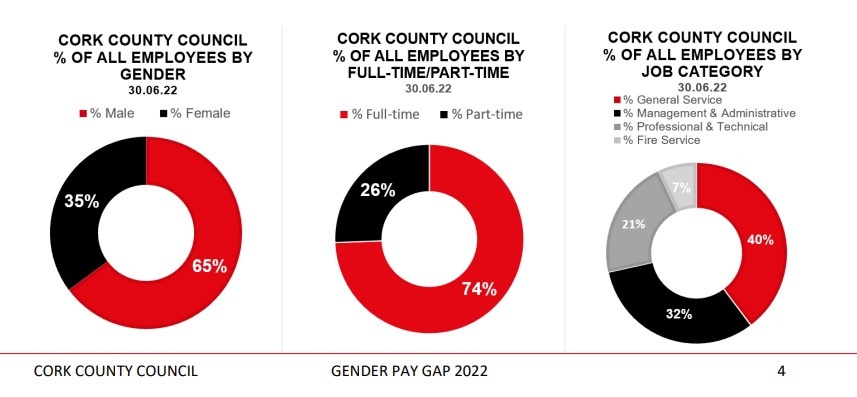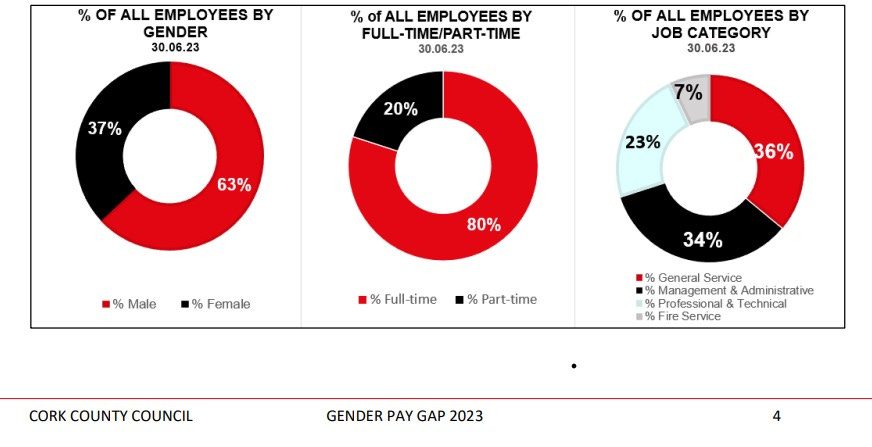Report: Cork County Council closes gender pay gap, increases full-time workers and managers
Could the salary of the first female boss at the local authority have tipped the scales?
One year on from its previous gender pay gap report, one of the largest local authorities in the country has revealed that, on average, female employees at Cork County Council now earn 0.5% more than their male counterparts.
In the gender pay gap report from 2022, male workers were paid 1.29% more than their female colleagues. According to the latest data, women workers at Cork County Council now earn 0.58% more than men.
Cork County Council employs approximately 2,500 workers, with 63% being men and 37% women. The majority of the local authority’s staff are in full-time employment (80%), while 20% work part-time. In 2022, 74% of the council's staff were full-time employees, with 26% working part-time."
In 2023, Cork County Council increased the number of workers in management and administration as well as in technical and professional services, while the number of staff employed in general services has fallen from 40% to 36%.
Gender pay gap, median and mean
Employers with more than 250 employees in Ireland are required to publish their gender pay gap data before the end of each calendar year and within six months of their reference date; Cork County Council and all local authorities in the country settled on June 30, 2023 as the reference date.
According to the Council’s report, “the Gender Pay Gap calculates the percentage difference between the average earnings of males and females irrespective of their role. The Gender Pay Gap is not the same as equal pay.”
The two key metrics the pay gap report examined are mean and median pay, as both are used to analyse and represent the differences in average earnings between male and female employees.
The median gender pay gap for 2023 shows that the median rate of pay for females is 10.59% higher than the median rate of pay for males.
As the Council’s report states, “It is useful to look at both the mean and median figures, as each one can tell us something different about the underlying factors affecting the pay gap. For example, a small number of higher paid employees can impact the mean figure and if this is the case, the median figure may be more representative of difference between what a male and a female is paid.”
Cork County Council’s highest paid earner is the Chief Executive who, according to a Department of Housing report from 2020, is the second highest paid CE in the country with a salary of €171,578. Tim Lucey, the long-standing Chief Executive, vacated the role earlier this year when he took over at Greyhound Racing Ireland.
Lucey was replaced by interim CE Valerie O’Sullivan, the first female boss of Cork County Council. Earlier this year, O’Sullivan claimed her X/Twitter account was “compromised”. Many of the 'likes' on the account were for posts about trans issues and poking fun at climate crisis protestors such as Greta Thunberg. The X account was subsequently deleted after T+D sent a list of questions to the Council.
“Publishing our gender pay gap data helps to reinforce our focus on supporting an open and inclusive workplace at Cork County Council. Our organisation is a place where all employees have the same opportunities for recognition and career development and are treated fairly and equitably,” O’Sullivan said about the publication of the latest gender pay gap report.
According to the Council, eight of the sixteen-member senior management team at the County Council are women.
From the archive:
How can we strengthen local government in Ireland?
Cinderella and the Constitution I cannot claim credit for coining the phrase that local government is the Cinderella of the Irish political system. It has been used by other academic scholars before and what they generally mean is that local government is under-studied, under-researc…







